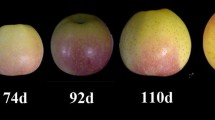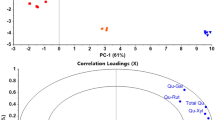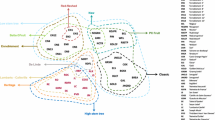Abstract
This paper summarises the information on the occurrence of phenolic compounds in apple Malus domestica leaves and fruits with special reference to their developmental changes and regulation of biosynthesis. Besides the ontogenetic variation in biosynthesis and accumulation, the stress-induced and pathogenesis-related changes are emphasised. Aspects of commercial importance are addressed, ranging from fruit colouration, through disease resistance, to the direct use of apple tissues, as raw material for the extraction of bioactive phenolic compounds.
Similar content being viewed by others
References
Abdallah A.Y., Gil M.I., Biasi W. and Mitcham E.J. 1997. Inhibition of superficial scald in apples by wounding: changes in lipids and phenolics. Postharvest. Biol. Technol. 12: 203–212.
Amiot M.J., Tacchini M., Aubert S. and Nicholas J. 1992. Phenolic composition and browning susceptibility of various apple cultivars at maturity. J. Food Sci. 57: 958–962.
Aubert S., Amiot M.J. and Nicolas J. 1992. Les critères de brunissement des pommes. Sci. Aliments. 12: 625–647.
Bengoechea M.L., Sancho A.I., Bartolomé B., Estrella I., Gómez-Cordovés C. and Hernández M.T. 1997. Phenolic composition of industrially manufactured purées and concentrates from peach and apple fruits. J. Agric. Food Chem. 45: 4071–4075.
Bensath A., Ruysnyak T. and Szent-Györgii A. 1936. Vitamine nature of flavones. Nature 138: 789–793.
Beveridge T., Harrison J.E. and Weintraub S.E. 1997. Procyanidin contributions to haze formation in anaerobically produced apple juice. Lebensm-Wiss u-Technol. 30: 594–601.
Bilyk A., Hicks K.B., Bills D.D. and Sapers G.M. 1988. Application of HPLC and dual wavelength detection to the analysis of phenolic compounds in apples. J. Liq. Chromatogr. 11: 2829–2841.
Borejsza-Wysocki W., Lester C., Attygalle A.B. and Hrazdina G. 1999. Elicited cell suspension cultures of apple (Malus x domestica) cv. Liberty produce biphenyl phytoalexins. Phytochemistry 50: 231–235.
Coseteng M.Y. and Lee C.Y. 1987. Changes in apple polyphenoloxidase and polyphenol concentration in relation to degree of browning. J. Food Sci. 52: 985–989.
De Pascual-Teresa S., Treutter D., Rivas-Gonzalo J.C. and Santos-Buelga C. 1998. Analysis of flavanols in beverages by HPLCchemical reaction detection. J. Agr. Food Chem.: 4209–4213.
Escarpa A. and González M.C. 1998. High-performance liquid chromatography with diode-array detection for the determination of phenolic compounds in peel and pulp from different apple varieties. J. Chromatogr. A. 823: 331–337.
Feucht W. and Treutter D. 1999. The role of flavan-3-ols in plant defense. In: Inderjit (ed.), Principles and Practices in Chemicl Ecology. CRC Press, Boca Raton, pp. 307–338.
Feucht W., Treutter D. and Schwalb P. 1998. Principles of barrier formation of scab.infected apple fruits. J. Plant Dis. Prot. 105:394–403.
Foo L.Y. and Porter L.J. 1981. The structure of tannins of some edible fruits. J. Sci. Food Agric. 32: 711–716.
Geibel M., Treutter D. and Feucht W. (Eds.) 1994. Natural Phenols in Plant Resistance. Acta Horticulturae 381. International Society for Hort. Sci., Wageningen.
Gómez-Cordovés C., Varela F., Larrigaudiere C. and Vendrell M. 1996. Effect of ethephon and seniphos treatments on the anthocyanin composition of Starking apples. J. Agric. Food Chem. 44: 3449–3452.
Gorski P.M. and Creasy L.L. 1977. Color development in Golden Delicious apples. J. Amer. Soc. Hort. Sci. 102: 73–75.
Guyot S., Doco T., Souquet J.-M., Moutounet M. and Drilleau J.F. 1997. Characterization of highly polymerized procyanidins in cider apple (Malus sylvestris var. Kermerrien) skin and pulp. Phytochemistry 44: 351–357.
Guyot S., Marnet N., Laraba D., Sanoner P. and Drilleau J.-F. 1998. Reversed-phase HPLC following thiolysis for quantitative estimation and characterization of the four main classes of phenolic compounds in different tissue zones of a French cider apple variety (Malus domestica Var.Kermerrien). J. Agric. Food Chem. 46: 1698–1705.
Hernandez T., Ausin N., Bartolomé B., Bengoechea L., Estrella I. and Gómez-Cordovés C. 1997. Variations in the phenolic composition of fruit juices with different treatments. Z. Lebensm. Unters. Forsch. A. 204: 151–155.
Herrmann K. 1990. Vorkommen und Gehalte der Flavonoide in Obst. II. Flavonolglycoside, Anthocyanine und Dihydrochalcone. Erwerbsobstbau 32: 32–37.
Hrazdina G., Borejsza-Wysocki W. and Lester C. 1997. Phytoalexin production in an apple cultivar resistant to Venturia inaequalis. Phytopathology 87: 868–876.
Hunter L.D. 1975. Phloridzin and apple scab. Phytochemistry 14: 1519–1522.
Hunter M.D. and Hull L.A. 1993. Variation in concentrations of phloridzin and phloretin in apple foliage. Phytochemistry 34: 1251–1254.
Ju Z., Yuan Y., Liu C., Wang Y. and Tian X. 1997. Dihydroflavonol reductase activity and anthocyanin accumulation in ‘Delicious', ‘Golden Delicious’ and ‘Indo’ apples. Sci. Hortic. 70: 31–43.
Ju Z., Yuan Y., Liu C., Zhan S. and Wang M. 1996. Relationships among simple phenol, flavonoid and anthocyanin in apple fruit peel at harvest and scald susceptibility. Postharvest. Biol. Technol. 8: 83–93.
Ju Z.-G., Liu C. and Yuan Y. 1995a. Activities of chalcone synthase and UDPGal:flavonoid-3-O-glycosyltransferase in relation to anthocyanin synthesis in apple. Sci. Hortic. 63: 175–185.
Ju Z.-G., Yuan Y.-B., Liou C.-L. and Xin S.-H. 1995b. Relationship among phenylalanine ammonia-lyase activity, simple phenol concentrations and anthocyanin accumulation in apple. Sci. Hortic. 61: 215–226.
Kermasha S., Goetghebeur M., Dumont J. and Couture R. 1995. Analyses of phenolic and furfural compounds in concentrated and non-concentrated apple juices. Food Res. Intern. 28: 245–252.
Knekt P., Järvinen R., Reunanen A. and Maatela J. 1996. Flavonoid intake and coronary mortality in Finland: a cohort study. British Medical Journal 312: 478–481. Figure 8. Generation of 3-hydroxyphloridzin by polyphenoloxidase in the presence of ascorbic acid, after (Hunter 1975; Ridgway et al. 1997). 87
Kondo S., Uthaibutra J. and Gemma H. 1991. Comparison of 1-aminocyclopropane-1-carboxylic acid, abscisic acid and anthocyanin content of some apple cultivars during fruit growth and maturation. J. Japan Soc. Hort. Sci. 60: 505–511.
Lancaster J.E. 1992. Regulation of skin colour in apples. Crit. Rev. Plant Sci. 10: 487–502.
Lea A.G.H. 1990. Bitterness and astringency: the procyanidins of fermented apple ciders. In: Roussef R.L. (ed.), Bitterness in Food and Beverages. Elsevier, New York, pp. 123–143.
Lea A.G.H. and Beech F.W. 1978. The phenolics of ciders: effect of cultural conditions. J. Sci. Food Agric. 29: 493–496.
Lee C.Y. 1992. Emzymatic oxidation of phenolic compounds in fruits. In: Ho C.T., Lee C.Y. and Hang M.T. (eds), Phenolic compounds in food and their effects on health, I. Analysis, Occurence, Chemistry, Amer. Chem. Soc., pp. 305–317.
Li P., Wang X.-Q., Wang H.-Z. and Wu Y.-N. 1993. High performance liquid chromatographic determination of phenolic acids in fruits and vegetables. Biomedical and Environmental Sciences 6: 389–398.
Lister C.E., Lancaster J.E., Sutton K.H. and Walker J.R.L. 1994. Developmental changes in the concentration and composition of flavonoids in skin of a red and a green apple cultivar. J. Sci. Food Agric. 64: 155–161.
Lister C.E., Lancaster J.E., Sutton K.H. and Walker J.R.L. 1997. Aglycone and glycoside specificity of apple skin flavonoid glycosyltransferase. J. Sci. Food Agric. 75: 378–382.
Lister C.E., Lancaster J.E. and Walker J.R.L. 1996a. Phenylalanine ammonia lyase (PAL) activity and its relationship to anthocyanin and flavonoid levels in New Zealand-grown apple cultivars. J. Amer. Soc. Hort. Sci. 121: 281–285.
Lister C.E., Lancaster J.E. and Walker J.R.L. 1996b. Developmental changes in enzymes of flavonoid biosynthesis in the skins of red and green apple cultivars. J. Sci. Food Agric. 71: 313–320.
Lu Y. and Foo L.Y. 1997. Identification and quantification of major polyphenols in apple pomace. Food Chemistry 59: 187–194.
Lu Y. and Foo L.Y. 1998. Constitution of some chemical components of apple seed. Food Chemistry 61: 29–33.
Lux-Endrich A., Kern S. and Treutter D. 1999. Phenolakkumulation in Zellkulturlinien der Apfelsorte ‘Alkmene'. J. Appl. Bot.: 145–151.
Macheix J.J., Suen R. and Ibrahim R.K. 1981. Metabolism of phenylpropanoid compounds in apple fruit cell suspension culture. Biochem. Physiol. Pfl. 176: 195–205.
Mayr U. 1995. Einfluß des Phenolstoffwechsels beim Apfel (Malus domestica) auf das Resistenzpotential gegen Apfelschorf (Venturia inaequalis).
Mayr U., Batzdorfer R., Treutter D. and Feucht W. 1994. Surfactant-induced changes in phenol content of apple leaves and fruit skins. Acta. Hort. 381: 479–487.
Mayr U., Fünfgelder S., Treutter D. and Feucht W. 1995. Induction of phenol accumulation by pesticides under the control of environmental factors. In: Manka M. (ed.), Environmental biotic factors in integrated plant disease control., Poznan, pp. 399–402.
Mayr U., Michalek S., Treutter D. and Feucht W. 1997. Phenolic compounds of apple and their relationship to scab resistance. J. Phytopathol. 145: 69–75.
Mayr U. and Treutter D. 1996. Vorkommen und Gehalte von Flavanolen in Apfelfrüchten und -säften. In: Die Qualität pflanzlicher Nahrungsmittel als Grundlage richtiger Ernährung. Deutsche Gesellschaft für Qualitätsforschung, Freising, pp.113–118.
Mayr U. and Treutter D. 1998. Flavanols as defence barriers in apple leaves against the apple scab fungus (Venturia inaequalis). Acta. Hort. 466: 79–82.
Mayr U., Treutter D. and Feucht W. 1996. Phenolic compounds of apple fruit. Erwerbsobstbau. 38: 8–12.
Mayr U., Treutter D., Santos-Buelga C., Bauer H. and Feucht W. 1995. Developmental changes in the phenol concentrations of ‘Golden Delicious’ apple fruits and leaves. Phytochemistry 38:1151–1155.
Mazza G. and Velioglu Y.S. 1992. Anthocyanins and other phenolic compounds in fruits of red-flesh apples. Food Chem. 43: 113–117.
McRae K.B., Lidster P.D., DeMarco A.C. and Dick A.J. 1990. Comparison of the polyphenol profiles of apple cultivars by correspondence analysis. J. Sci. Food Agr. 50: 329–342.
Michalek S. 1997. Stimulierung der Phenolbiosynthese des Apfels (Malus domestica) im Hinblick auf Induzierte Resistenz. Shaker Verlag.
Michalek S., Klebel C., Treutter D. and Feucht W. 1999. Stimulation of flavanol biosynthesis in apple (Malus domestica) by abiotic elicitors.
Miller N.J. and Rice-Evans C.A. 1997. The relative contributions of ascorbic acid and phenolic antioxidants to the total antioxidant activity of orange and apple fruit juices and blackcurrant drink. Food Chem. 60: 331–337.
Mosel H.D. and Herrmann K. 1974. The phenolics of fruits III. The contents of catechins and hydroxy-cinnamic acids in pome and stone fruits. Z. Lebensm-Unters-Forsch. 154: 6–11.
Murata M., Kurokami C. and Homma S. 1992. Purification and some properties of chlorogenic acid oxidase from apple (Malus pumila). Biosci. Biotech. Biochem. 56: 1705–1710.
Orzmianski J., Sokó-lLetowska A. and Kuczynski A. 1995. Effect of rhubarb juice on phenolics and colour of unclarified apple juice. Quality Control: 179-182.
Pérez-Ilzarbe J., Hernández T. and Estrella I. 1991. Phenolic compounds in apples: varietal differences. Z. Lebensm. Unters. Forsch. 192: 551–554.
Pincinelli A., Dapena E. and Mangas J.J. 1995. Polyphenolic pattern in apple tree leaves in relation to scab resistance. A preliminary study. J. Agric. Food Chem. 43: 2273–2278.
Piretti M.V., Gallerani G. and Brodnik U. 1996. Polyphenol polymerisation involvement in apple superficial scald. Postharvest. Biol. Technol. 8: 11–18.
Plumb G.W., Chambers S.J., Lambert N., Bartolomé B., Heaney R.K., Wanigatunga S. et al. 1996. Antioxidant actions of fruit, herb and spice extracts. J. Food Lipids. 3: 171–188.
Rademacher W., Speakman J.B., Evans R.R., Evans J.R., Römmelt S., Michalek S. et al. 1998. Prohexadione-Ca-a new plant growth regulator for apple with interesting biochemical features. In: Schafer W.E. (ed.), Proc. of the 25th Annual Meeting of The Plant Growth Regulation Society of America., Chicago, pp. 113–118.
Ridgway T., Tucker G. and Wiseman H. 1997. Novel bioconversions for the production of designer antioxidant and colourant flavonoids using polyphenol oxidases. Biotechnol. Genetic Engeneering Rev. 14: 165–190. 88
Risch B. and Herrmann K. 1988. Die Gehalte an Hydroxyzimtsäure-Verbindungen und Catechinen in Kern-und Steinobst. Z. Lebensm. Unters. Forsch. 186: 225–230.
Ritter G. and Dietrich H. 1996. Der Einfluss moderner Verfahrenstechniken auf den Gehalt wichtiger Pflanzenphenole im Apfelsaft. Flüssiges Obst. 63: 256–263.
Römmelt S., Treutter D., Speakman J.B. and Rademacher W. 1999. Effects of prohexadione-Ca on the flavonoid metabolism of apple with respect to plant resistance against fire blight. Acta. Hortic. 489: 359–363.
Sannomaru Y., Katayama O., Kashimura Y. and Kaneko K. 1998. Changes in polyphenol content and polyphenoloxidase activity of apple fruits during ripening process. J. Japan Soc. Food Sci. Technol. 45: 37–43.
Siebert K.J., Troukhanova N.V. and Lynn P.Y. 1996. Nature of polyphenol - protein interactions. J. Agr. Food Chem. 44: 80–85.
Suárez-Vallés B., Santamaria-Victorero J., Mangas-Alonso J.J. and Blanco-Gomis D. 1994. High-performance liquid chromatography of the neutral phenolic compounds of low molecular weight in apple juice. J. Agric. Food. Chem. 42: 2732–2736.
Teuber H. and Herrmann K. 1978. Flavonolglycoside des Apfels (Malus sylvestris Mill.). Z. Lebensm. Unters. Forsch. 166: 80–84.
Treutter D. and Feucht W. 1990a. The pattern of flavan-3-ols in relation to scab resistance of apple cultivars. J. Hort. Sci. 65:511–517.
Treutter D. and Feucht W. 1990b. Accumulation of flavan-3-ols in fungus-infected leaves of Rosaceae. Z. PflKrankh. PflSchutz. 97: 634–641.
VanBuren J.P. 1989. Causes and prevention of turbidity in apple juice. In: Downing D.L. (ed.), Processed Apple Products., New York, pp. 97–120.
Versari A., Biesenbruch S., Barbanti D. an d Farnell P.J. 1997. Adulteration of fruit juices: dihydrochalcones as quality markers for apple juice identification. Lebensm-Wiss u Technol. 30: 585–589.
Wald B. and Galensa R. 1989. Nachweis von Fruchtsaftmanipulationen. Z. Lebensm. Unters. Forsch. 188: 107–114.
Workman M. 1963. Color and pigment changes in Golden Delicious and Grimes Golden apples. J. Amer. Soc. Hortic. Sci. 83: 149–161. 89
Author information
Authors and Affiliations
Rights and permissions
About this article
Cite this article
Treutter, D. Biosynthesis of phenolic compounds and its regulation in apple. Plant Growth Regulation 34, 71–89 (2001). https://doi.org/10.1023/A:1013378702940
Issue Date:
DOI: https://doi.org/10.1023/A:1013378702940




